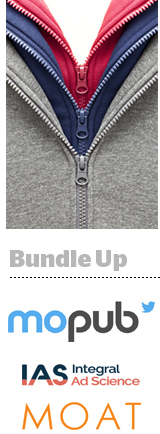
MoPub is getting very cozy with its viewability vendors.
On Thursday, the Twitter-owned mobile ad exchange released the latest version of its SDK, bundled with viewability support from Integral Ad Science and Moat. MoPub’s SDK is integrated with just shy of 50,000 apps.
As the buy side bangs the drum on independent verification and uniform viewability standards, app publishers have been left scratching their heads and scrambling.
One publisher that participated in MoPub’s roughly nine-month-long beta test of the viewability-enabled SDK found it “a bit jarring” when advertisers started demanding third-party viewability measurement as a prerequisite for doing business, said Meridith Miller, MoPub’s head of commercial partnerships.
“They started getting requests about a year ago from advertisers that wanted them to integrate with Moat and Integral,” Miller said. “They realized they needed to integrate additional SDKs to win RFPs.”
But app developers dislike integrating more SDKs, which can bloat their app, make it crash and lead to other usability issues.
“Having viewability bundled as part of the MoPub SDK just makes life easier for the publisher,” said Jason Cooper, GM of mobile at Integral Ad Science.
MoPub first hooked up with Integral and Moat in April, but didn’t provide full viewability support within its SDK until this latest iteration. Prior to the release, if a publisher wanted its inventory to be measurable by IAS or Moat, it would need to integrate each separately.
Moat and IAS also get more scale through the partnership without having to send sales teams out to pitch publishers directly.
MoPub’s plan is to enable more choice directly within its SDK, whether that’s through incorporating more viewability providers or by working more closely with the ongoing industry initiative spearheaded by IAS to open source the code for measuring in-app viewability. The IAB Tech Lab assumed responsibility for managing the code in January.
The purpose of the open-source project is to enable publishers to work with multiple viewability vendors minus the headache of having to integrate multiple viewability SDKs.
It’s still uncertain what the future of in-app viewability measurement will look like, but one thing is clear: Advertisers are obsessed with viewability.
“And publishers know that if they want to unlock brand dollars and bring in brand-based revenue, they’ve got to provide viewability,” Cooper said.
It’s unusual for a large platform like MoPub that’s owned by a walled garden like Twitter to allow a third party to set up camp within the inner sanctum of its SDK, but MoPub wants to be on the right side of history.
“It’s scary opening yourself up to measurement, but we have confidence in the performance of our publishers’ inventory,” Miller said. “It’s not a decision we took lightly.”
As to whether other large-scale players like Facebook or Google would ever follow suit, Miller hopes so.
“Given the demands that advertisers are, and frankly should be, making, we’re going to see more of this,” she said. “If it’s the ‘year of viewability,’ that would be a great thing, especially for in-app, which has been a challenge. This is an important step one, but it’s really just the beginning of how we’re thinking about viewability measurement.”
This post was syndicated from Ad Exchanger.

More Stories
Pew Survey Shows Education Level and Party Affiliation Tied to Views on Freedom of the Press
Google Tops Q1 Estimates with $90B in Revenue Amid Antitrust Turmoil
The Tobacco-Free Future of Phillip Morris With Marian Salzman